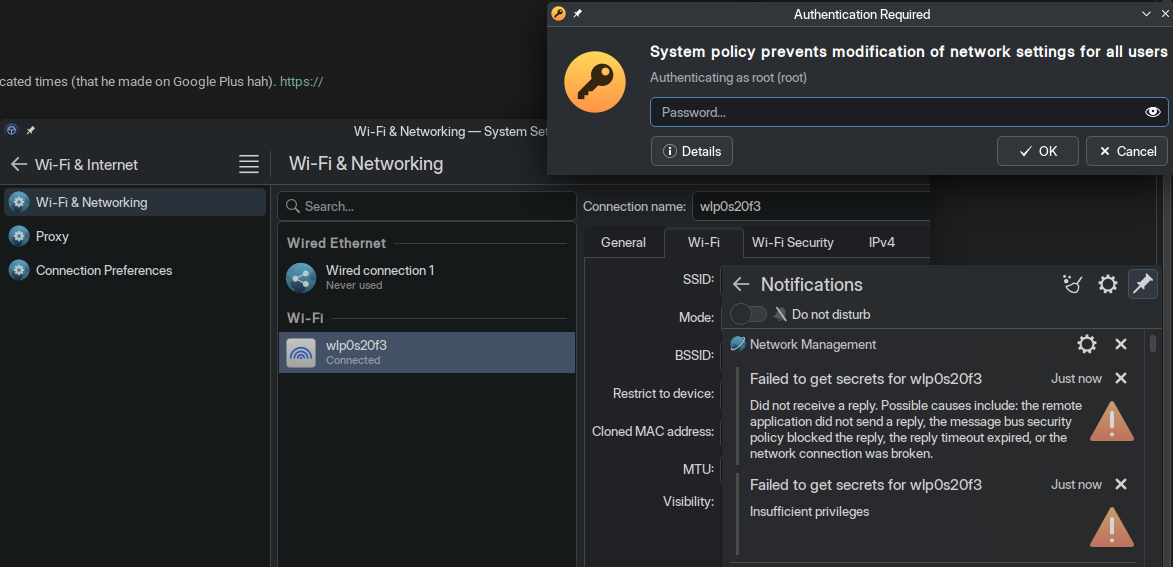Any recommendations for a linux distro that i can set up and be reasonably sure my non techy SO won’t break accidentally? The set up doesn’t have to be easy it just has to not break once I leave her alone with it. My first thought was popOS.
My plan is to have 2 profiles and not give her access to sudo. I just don’t want to have to go into it unless she needs a new program.
Mint.
I have my mum (67) and my partner using it.
Libre office and Firefox cover 99.9% of all the things mum actually does.
My partner uses blender, krita and audacity also.
Auto updates… Almost no tech support.
Linux mint makes sense. Auto updates and its hastle free for non techy person like me.
Even if I’m doing something crazy , chatgpt to the rescue.
Fedora Silverblue.
Or really any immutable OS; they would have to go way out of their way to even edit system files, much less break the system. I just recommend Silverblue because gnome is really hard for an inexperienced user to break.
Semi-serious suggestion: Guix or NixOS. They’re not break-safe per se, but if they do break something, you can use the OS’ previous generations to go back to an operational state. Just… don’t let them use the commands that delete older generations.
(Semi-serious because they’re both not exactly mainstream and not eactly conventional in their setup.)
Yep, NixOS as a base + some Flatpak store for installing apps. In fact, use impermanence to just drop all OS state apart from logs, network settings and flatpaks. That way, “turn it off and then on again” will almost always work to fix the OS.
I’m gonna be the boring guy.
RedHat Enterprise Linux. (Or Rocky)
Most boring distro ever. Install it, turn on all the auto updates and be happy. Install something to take backups. Ignore any new major-releases, that laptop will die before the OS hits EOL.
Benefits:
- Boring. It’s their tool, not your plaything.
- Actually works
- Will be reasonably secure over time with minimal effort and manual intervention.
- If any commercial Linux software is required, it will most likely only be supported on RHEL or Ubuntu.
- Provides web browser and word-processing. And we don’t need anything else.
Drawbacks:
- Boring (for you)
- Not ideal for gaming
If you install anything else than RHEL-derivatives or possibly Ubuntu on a machine that someone else will use, you are both in for a world of pain. It has to ”just work” without intervention by you, and it needs to keep working that way for the next 5 years.
Source: Professionally deploying and supporting multiuser desktop Linux to a few thousand users other than myself.
In the era of Flatpak, I kind of agree with you.
The primary drawback is the complete lack of packages. A home user is going to want something not included and then things fall apart. Flatpaks and Distrobox have made that a lot better.
If you could get away with a RHEL core and Flatpak for apps, you would have a pretty solid setup for a “normal” person.
I both agree with you, and kinda disagree.
If you venture into installing Flatpaks on such a system, just keep in mind that:
- Auto updates must be on
- The Maintainer of the Flatpak in question must be expected to provide security updates for the next five years or so. Personally, I’d only use it for packages provided directly by project maintainers (i.e. Dropbox from Dropbox Inc. as packaged by Dropbox Inc.).
Keep in mind, like 95% of normal people (we are not normal) don’t know what a package manager is and only use
- ”The internet”
- Webmail
- Google Docs
- Spotify
For that, we need the default desktop install and the Spotify app (probably a Flatpak). That’s about it. It’s a glorified web browser with batteries. Treat it that way and keep it that way, unless your SO has any specific needs and requirements.
The limited and dated package set is kind of a feature. Only packages that should work until the laptop breaks, and only packages that won’t change randomly when you update (mostly).
Really seems like we are agreeing. I get that the limited package set is a feature. I also get that it is both too small and too enterprise to satisfy most people you would describe as a “SO” precisely because they are probably normal people.
You gave the excellent example of Spotify and suggested a Flatpak for that. Honestly, I am not sure where we are in disagreement. Especially since I started by “mostly agreeing” myself. We even agree on that. :)
deleted by creator
Use Bluefin or some other immutable/atomic distro.
The upside is that it’s rock solid and will likely never fail in a way that cant be easily rolled back. The downside being that it’s slightly more complex to administer than a traditional distro model (which probably isn’t a big problem if you are going to be administering your SO’s PC for the most part.)
Bluefin is basically a more general desktop, less gaming-focused version of Bazzite. Bluefin uses Gnome, but there’s also a KDE Plasma version called Aurora.
I’ve got my wife and 5 year old on slackware. They wouldn’t know how to screw it up if they wanted to!
Now that’s an extreme choice :D
Doing a lot of tech support, don’t you?
Nope! Everything just works and it’s rock solid. It’s also been my daily driver for over 20 years.
I was doing a lot of tech support when my wife was on endeavouros and my daughter was on bazzite. Tbf, my problems with bazzite were probably down to me not understanding the immutable distro concept.
I can absolutely expect Slackware to be solid; my concern is about user-friendliness :D
Not the easiest distro out there.
On the topic of immutable distros, I more or less understood them and kind of managed to work fine with them, but, honestly, I feel all they do is enforce a certain way to interact with the system that makes screwing it up very hard - but on the other hand, introduces a slew of non-standard and sometimes complicated solutions newbies won’t understand (even for veterans it takes a while to get a grasp on them). If you follow the same pipeline on a mutable distro, you get the same stability plus the ability to do a lot of things without jumping through the hoops.
Right now I ended up on classical non-atomic Fedora for this reason. It features a lot of safe practices from immutable distros - system snapshots before updating, prioritizing flatpaks, container-oriented terminal able to work with Distrobox among all other things - but at the same time it’s a mutable distro able to work with everything else.
I think Slackware’s reputation for being difficult dates back to the 90s when all linux was difficult. Slackware has evolved just like everyone else, just differently. It’s easy to install, and works like any other kde plasma based distro if you choose the default full install.
The two biggest differences are no systemd and package management. Slackpkg functions somewhat like apt-get, but only for official packages and updates. Everything else can be installed with slackbuild scripts that can be automated with sbopkg. This process is similar to using the AUR with a helper like yay. And I have some flatpaks installed too.
Fair!
But still, an installation process that doesn’t involve a package manager is a bit of a pain, comparatively. Flatpaks may certainly be very helpful, though.
There are tools to download, compile and install packages! Whether or how you use them is left up to the slacker. I use them, but I scrutinize most deps so that I’m not adding support for features I won’t use.
I see, yep.
Thanks for the response!
Any of the ostree variants of Fedora, be they Fedora Official or downstream ones like the Universal Blue family
An immutable distro would be a good choice. They are distros designed to be more resilient against failure. For a gamer, bazzite is a solid choice; otherwise, silverblue.
Aurora or Bluefin would be great, general purpose distros. They’re based on Fedora Kinoite and Silverblue, respectively, so you get that atomic unbreakability with the addition of some handy software and easy, optional scripts via
ujust.I have Bazzite on a laptop specifically for this reason, so if I ever kick the bucket early, they will have a reliable and portable computer.
Bazzite does seem like a good option, thanks.
Aurora gets a vote from me. I set it up for my technically repulsive father, and he gets on just fine with it.
Linux mint is a good, “click first” distro that won’t break without root + will be easy for her to use. For something with a more modern desktop and more recent updates, Bazzite is really good at just working and (in my experience) has never broken
I have tried most known distros but not bazzite, yet. might be the next one on my distrohop journey since everyone recommends it. hope it works better than fedora kde, it does not get along with my hardware AT ALL
Bazzite might be what i go for the more i look at it. Thanks
I like bazzite!
Here’s the bazzite attempt at viral marketing, everyone.
Remember when we saw it for MX Linux?
Be careful about what you install on your computers.
Edit: The incessant, vehement backlash against calling out shilling is always a telltale sign of shilling. Shills are not allowed to let people accuse them of shilling without going through their playbook of what to say next.
Its popular rnow because of all the handhelds I think
I mean it’s not perfect but what is?
I tried MX Linux for a while, it was okay. did I miss something?
I tried mx for 7 minutes. it installed nvidia drivers and that killed it. off to the next distro I hopped, knowing the problem could have been easy to fix. shame, it seemed interesting.
I never mentioned perfection.
I hope people reading this can start to recognize shilling when they see it.
Dude you might be paranoid…
Nah. I just wasn’t born yesterday.
“Someone mentions a distro they like” ≠ shilling. I use Bazzite and have been for months. Before that, used Nobara, EndeavourOS, and vanilla Fedora, along with a number of others I tried when I was distro-hopping. Wholeheartedly believe that Bazzite is currently the best generally-available Linux distro for gaming and is up there for general use. It’s not perfect, but nothing is - it gets close for the use-cases I mentioned, though.
Bro I’m the lead developer and I’m just now seeing this, just accept you called the viral marketing wrong.
We’ve grown to the point that when I market something, I tell people not to listen to me because I’m biased.
Any of them. Just don’t give the root password.
This is what I do with my mom and her boyfriend. I’ve had them on Linux for a few years now and neither have managed to break anything.
Might end up in dumb annoying situations like setting up wifi requiring root and such
That is not a thing in userspace. No idea what you’re even alluding to here.

Surprising amount of stuff requires root (or used to). It reminds me of this glorious rant from Linus from his less domesticated times (that he made on Google Plus hah). https://forums.freebsd.org/threads/linus-to-opensuse-devs-kill-yourself-now.30414/
The highlight:
So here’s a plea: if you have anything to do with security in a distro, and think that my kids (replace “my kids” with “sales people on the road” if you think your main customers are businesses) need to have the root password to access some wireless network, or to be able to print out a paper, or to change the date-and-time settings, please just kill yourself now. The world will be a better place.
Oof.
This is old as hell, and on a locked down account. You don’t need restrictions like this for a personal use machine, and a base install of any distro wouldn’t have this type of issue whatsoever. It is not a modern concern.
Friend, this is from my own system I’m running right now lol.
Oh wild, I thought “No way!”, but apparently yes way as I (Tumbleweed/KDE/Standard User) get all of this which I imagine would be disorienting to non-Linux users. Just going to Wi-Fi & Networking, not attempting to make any changes even.

Don’t have this issue on archlinux. I think there is a group, which if you are part of, you can change networking settings.
[moonpie@cachyos-x8664 ~]$ groups moonpie sys network wheel audio kvm lp storage video users rfkill libvirt docker moonpie
Then your account is not part of the proper groups to control NetworkManager as integrated in Gnome. That’s on you.
Friend, that’s KDE lol.
Set up Tailscale and an SSH key for remote tech support
Or just wireguard and ssh?
I prefer Manjaro, super easy.
Nixos with whatever defaults you don’t want her touching, then she can use nix profiles to install extra software if she wants
Has “non techy” evaded you ?
In fairness, there are attempts to make Nix user-friendly, such as SnowflakeOS, featuring a lot of improvements including a graphical app store etc, but those are alpha and not ready for an average user.
I guess it depends what she does on her pc.
But ignoring that, Mint without sudo. Throw in flatpaks and appimages.
Immutable distros are probably fine too but in my experience they tend to be a bit fussy if you need to change something in the system config.
Ubuntu, always a solid choice for beginners but Gnome shell is a bigger change from windows conpared to Cinamon.
P.S. I have Mint on our TV PC and my SO handdles it without issues.






